In 1981, Walt Disney Productions faced a major issue: with the exception of The Rescuers, all of its recent films, including the live action, family friendly films, had been underperforming for years. Walt Disney’s son-in-law, Ron Miller, who had worked as a producer on multiple live action films prior to becoming the president of Walt Disney Productions in 1978, believed he had a solution: Disney needed to start producing films aimed at an adult audience. The eventual result of this was Touchstone Pictures, Ron Miller’s major positive legacy to Disney. (His less positive legacies, less spoken of, included attempted corporate takeovers and his eventual ousting.) Meanwhile, Miller let people know that he was deliberately searching for “different” stuff, which is reportedly one reason why the galley proofs from Who Censored Roger Rabbit? ended up on his desk. Not to mention that the book name drops multiple Disney characters, and a small part of the plot references Disney’s Alice in Wonderland.
Ron Miller liked the concept, thinking it would fit into other Disney films that had combined live action film with animation. He optioned the book over the objections of his then boss Card Walker, and put the film into pre-production. At that point, things started going wrong.
The early test footage, shown to those lucky enough to be among the initial subscribers to the Disney Channel back in 1983, went over well with Miller, but not with the various directors and producers who saw the clips. Once Miller was ousted from Disney, the test footage was pulled from the Disney Channel and sent to the vault. There it languished, until Jeffrey Katzenberg and Eisner “found” it, along with other dropped projects. Katzenberg and Eisner felt dubious, but decided to get Steven Spielberg’s opinion. Spielberg liked it, and brought Robert Zemeckis, then best known for Back to the Future, on board as director. The film would, everyone agreed, after some negotiations, be a rarity: a partnership between Spielberg’s Amblin Entertainment and Disney’s Touchstone pictures.
This partnership had two immediate results. One, it freed up a lot more money for the film. Disney had originally planned to spend maybe $12 million—ok, maybe, possibly, if it turned out to be necessary, $25 million. The final budget ended up being around $70 million, something only possible thanks to Amblin. Two, Amblin’s involvement allowed Spielberg and Zemeckis to lobby for the rights to use various characters from other studios, something that that finally allowed Disney to cut through those tedious negotiations – and get Bugs Bunny on board.
It didn’t end these negotiations. Warner Bros fought over virtually every appearance of Bugs Bunny, which is why in the Bugs Bunny/Mickey Mouse scenes, Bugs Bunny speaks last—Disney finally gave up in exhaustion. Warner Bros also had strong opinions about the closing credits, which ended up being an uneasy compromise between Disney and Warner Bros: Porky Pig does his famous “That’s All, Folks!” and Tinker Bell voicelessly bangs her wand, allowing Warner Bros to have the last word and Disney to have the last image. And the studios were not able to obtain the rights to every character they had hopes for, meaning that Tom and Jerry and Rocky and Bullwinkle could not appear in this film.
In the end, however, they were able to bring in about 45 non Disney characters for various cameos. They also brought in Mel Blanc, who agreed to voice all but one of his Warner Bros characters (Yosemite Sam, a character the aging Blanc had always found physically difficult to voice) and Mae Questel, who had last voiced Betty Boop in 1939. They were also able to set up confrontations that animation fans had wanted for years—between Donald Duck and Daffy Duck, Mickey Mouse and Bugs Bunny, and Droopy Dog and any human coming within that character’s orbit. (And, I suppose, Porky Pig and Tinker Bell, although I’m not sure that counts as a confrontation, let alone a confrontation that fans were clamoring for.)
The rights issues more or less settled, the filmmakers had to tackle the next problems, both technical and story. Who Censored Roger Rabbit? had ended on a note that could kindly be called “depressing.” Although the original film treatment had stuck to a similar tone, Eisner, Spielberg and Zemeckis all wanted a more cheerful ending—especially since the film would eventually be released under a Disney label. The pornography in the original novel also had to go—replaced by what turned out to be a rather good gag involving Jessica Rabbit and a moment of “pattycake.”
Other changes included focusing on characters from animated cartoons instead of newspaper strips, which also allowed the film to drop the conceit used in the book of having Toons speak in word bubbles, instead of normally. The film also gave Eddie Valiant a reason to hate working with Toons—”A Toon killed his brother,” simultaneously giving Eddie a good reason to be an alcoholic (in a nice message for the kiddies, he does stop drinking midway through the film), letting audiences know that yes, Toons can be dangerous, and giving the film another great line.
The real mess involved combining live action with animation. Much of this involved the basics of forcing Bob Hoskins, playing human Eddie Valiant, to act against empty air, but other bits included the tricky effects shots that would involve cartoons interacting with real objects, like bicycles, cars, glasses, plates and heavy machines. In some cases—a shot of Jessica Rabbit in a car, for instance—this proved simple enough. But a three second shot of the pelican from Dumbo delivering mail via bicycle turned out to be mildly nightmarish: effects artists could not keep the bicycle upright, even with different forms of wirework, and eventually just allowed the bicycle to fall over, with the pelican, in the final film.
The process involved shooting live action first, and then producing still photographs from the film, which animators traced over into order to create the final cels. For the first time in Disney production since Sleeping Beauty, all of the cels were once again handpainted and colored, since the xerographic system, still in use, could not be adjusted for this film. That in turn meant that principal photography was completed long before the film was—meaning that nothing could be reshot, forcing animators to get creative with certain scenes where Bob Hoskins or other actors had been looking at the wrong place. In one scene, for instance, the animators had Roger Rabbit stand on his toes; in another sequence, Jessica Rabbit bent both her knees.
The results proved worth the effort—Who Framed Roger Rabbit? does have missed shots here and there, but for the most part, the only shot that looks really bad is the obvious greenscreen shot of Eddie getting tossed from the club, where the lighting and compositing don’t quite work—a problem more with the greenscreen shot than with the animated gorilla behind Eddie, and a problem films and TV still continue to struggle with today.
Otherwise, the film holds up remarkably well even today, with all of the advances in CGI, thanks largely to the performances of Bob Hoskins and Christopher Lloyd—the latter clearly having the time of his life. And also the gags—the Donald Duck and Daffy Duck bit is not just a technical masterpiece, but genuinely hilarious, as are many of the Toontown episodes and bits from the final confrontation sequence—including the moment when Eddie attempts to whip out a cartoon sword, only to hear the sword crooning with a rather unexpected voice.
I do find myself cringing a bit at the Lena Hyena bits—a takeoff on some 1930s and 1940s cartoons featuring ugly cartoon women chasing terrified men, and at the way Baby Herman ends up slapping a number of women’s butts. But to – somewhat – counter that, in another scene, Betty Boop delivers one of my favorite bits of the film: after Eddie expresses incredulity that someone like Jessica Rabbit could possibly be interested in someone like Roger Rabbit, Betty swiftly responds, that yeah, Jessica’s a lucky girl.
It’s hardly the first or the last time that a Disney film emphasized the importance of character over appearance. Indeed, in a few years Disney would build an entire film around that message, however strange it might sound coming from an industry nearly obsessed with appearances. And yes, the line—and the entire relationship between Roger and Jessica Rabbit—is a bit of wish fulfillment fantasy of the geeky, strange guy getting the hot girl. But it’s still a nice bit in a film that is otherwise very much about appearances and judging people (usually negatively) on these appearances, not to mention a film very much aware of the rampant sexism in 1940s Hollywood and Los Angeles, and a film where almost every woman, even those in bit parts and cameos, end up objectified in one way or another—by both live action and cartoon characters.
Interestingly enough, the only two women to comment on/protest this objectification are the two women explicitly drawn to be objectified sex symbols: Betty Boop and Jessica Rabbit. Betty, of course, is having a few issues since she’s a black and white cartoon in an age of Technicolor, making her extremely aware of the issues. Jessica argues that “I’m not bad. I’m just drawn that way.” Her body, of course, has been deliberately drawn to be a sex symbol, something she uses in her job as a cartoon night singer. It’s also something used against her—character after character dismisses her as “bad,” with nearly every character (including two women) immediately assuming that of course a woman who looks like that would be cheating on her husband. The only person not to believe this, or to see Jessica Rabbit as pure sex symbol: that husband. When shown the pattycake pictures, he’s devastated—but then concludes, correctly, that it’s a setup. No one—cops, weasels, Eddie, his boss—believes him.
Because, well, look at Jessica.
And yet, as the movie makes clear, Jessica’s far more than that—indeed, she’s arguably the most complex character in the film. She doesn’t so much grow as a character as reveal different layers: first as a nightclub singer using her blatant sexuality as part of her act; then that same nightclub singer harassed by the club owner into playing patty cake. And it is harassment—Jessica specifically says that she doesn’t want to, only giving in after Marvin Acme continues to insist. Later, Roger Rabbit reveals still more layers: a woman giving into blackmail to keep her husband employed, a woman who, as she tells Eddie, would do anything for her husband; then an investigator; then a woman more than capable with a gun who is also willing to fight to save her husband and Toontown; a woman with a gift for rhyme; and finally, a woman desperately in love with a rabbit. She turns out not to be the hinted at golddigger, interested in manipulating men for money, but a woman who chooses a rabbit because the rabbit makes her laugh. She’s not ashamed of her sexuality, or afraid to use it, but she turns out to be far, far more than what she was drawn to be.
Betty Boop, meanwhile, uses the sexuality she was drawn with to remain employed—and make comments on certain assumptions. The end result is a film surprisingly explicit about the negative effects of these assumptions and of sexual harassment: it’s very clear that had Marvin Acme, who claimed to love Toons so much, backed off the second Jessica Rabbit told him to, that none of the problems the Toons end up facing, which includes, not mildly, their complete destruction, would have happened. And he’d be alive.
Against this, I have to admit that the four human women with speaking parts don’t come out nearly as well—three of them are assistants of one kind or another, and one is stuck in the thankless role of the on and off girlfriend, with little to do. Then again, this is a film focused more on the cartoons than the people.
Which is to say, you can also just ignore all of this and laugh cruelly as Tweety Bird undoes every single one of Eddie’s fingers and lets him drop to the ground while Mickey Mouse and Bugs Bunny casually watch, or think that maybe—just maybe—Eddie would have been better off bringing a real, not cartoon gun, into Toontown. Jessica Rabbit does, after all, and that decision serves her well.
The comedy helped make Who Framed Roger Rabbit an unquestioned box office smash, earning back over four times its budget in domestic receipts alone in its initial release. Reports that the VHS and laserdisc release contained unmistakable proof that Jessica Rabbit was going commando in several shots (not visible at regular speed) helped propel high sales of both. The film also earned four Academy Awards, unprecedented for a combined live-action/film. Disney also used the film as an inspiration for Mickey’s Toontown, added to Disneyland (in 1993) and Tokyo Disneyland (in 1996), and temporarily to the Magic Kingdom (in 1996, now just part of Fantasyland), and naturally, merchandise ranging from T-shirts to plush animals to jewelry and more. Sales eventually declined, so Disney took most of this off the market in the last few years, but you can still find various Roger and Jessica Rabbit Christmas ornaments and art objects in the theme parks if you look.
Arguably, however, the film ended up having an even greater effect on other studios, including Spielberg and Amblin Entertainment. The success of the film helped reignite Spielberg’s never quite dead interest in the old Warner Bros cartoons, which in turn led Spielberg to back the joint Amblin/Warner Bros productions Tiny Toon Adventures, Animaniacs, Freakazoid! and Pinky and the Brain, which formed a critical part of the overall animated renaissance of the 1990s. That in turn spurred Disney to greater effort and helped Pixar persuade skeptical executives that really, yes, there might just be an audience for a computer animated film featuring talking toys.
Meanwhile, the success of Who Framed Roger Rabbit energized the Disney studio, convincing them—and studio executives—that yes, a large audience—even a large adult audience—still existed for animation. It also freed up some last minute funds to do some additional work on a film that animators were feeling increasingly good about—a little cheerful thing about a mermaid.
First, however, the studio had another film to release—about some singing dogs and cats. Oliver Twist and Oliver and Company, coming up next.
Mari Ness lives in central Florida.



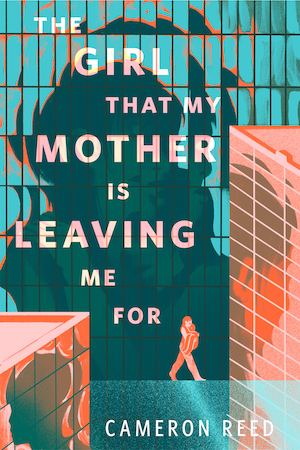
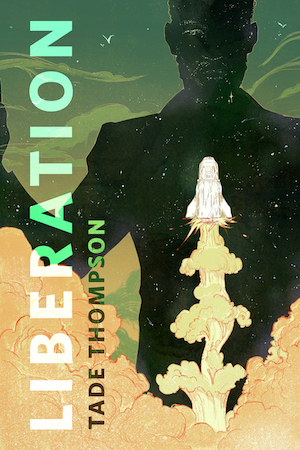





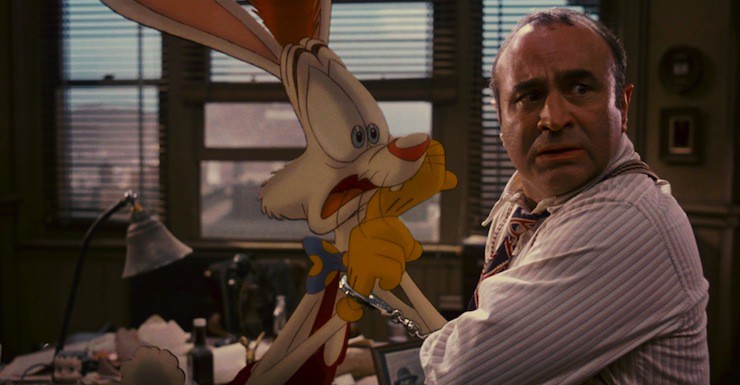
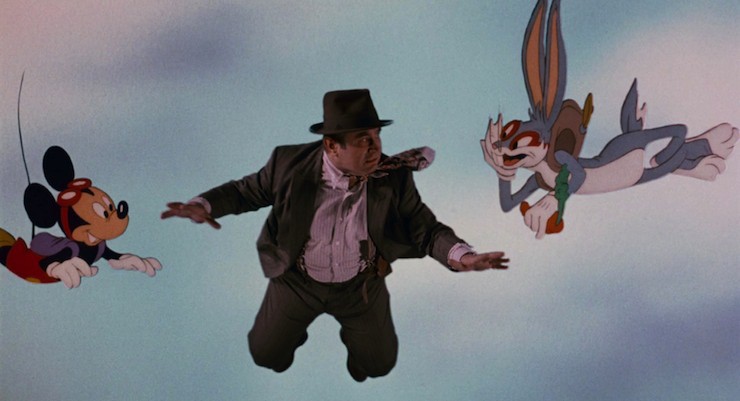
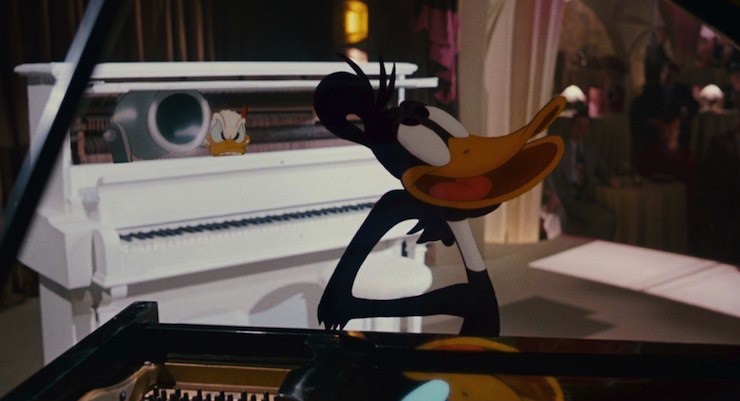
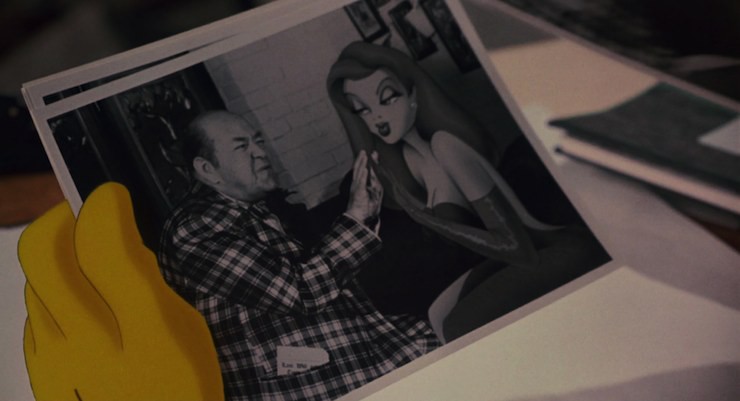
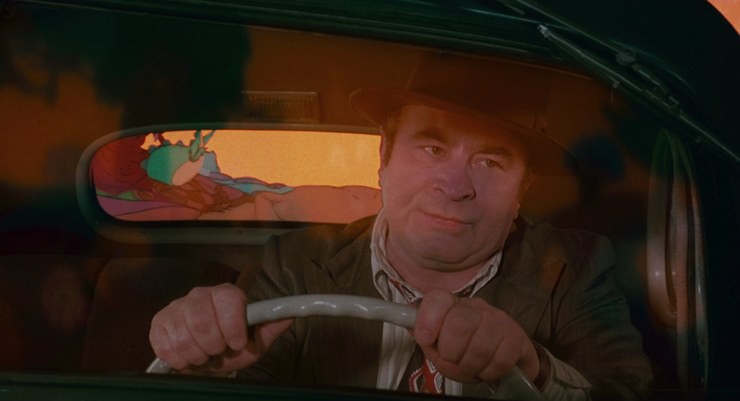
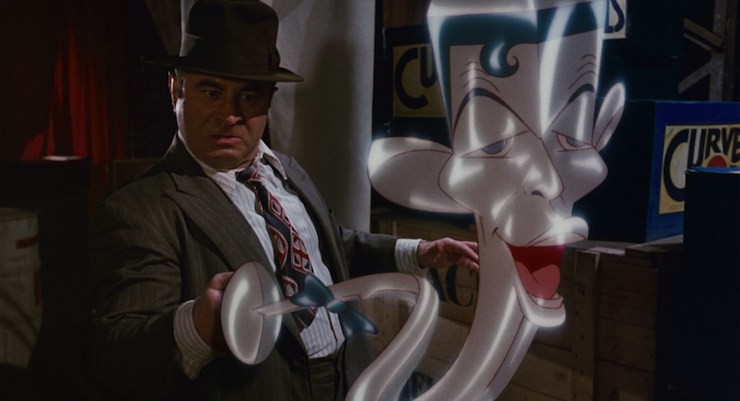
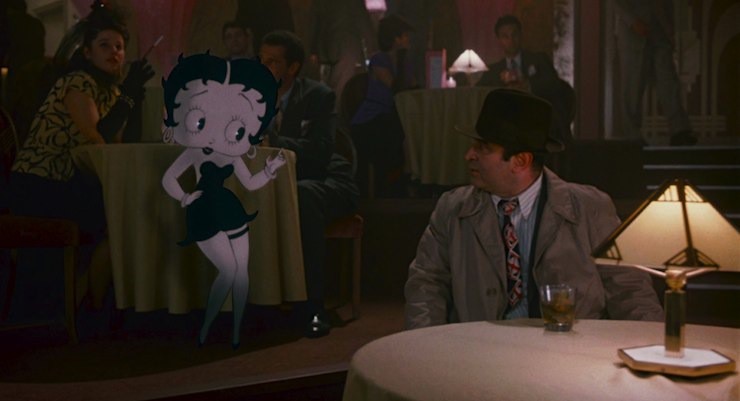
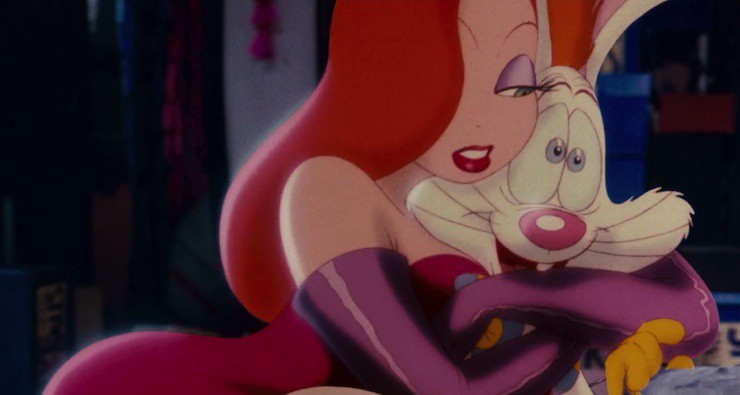
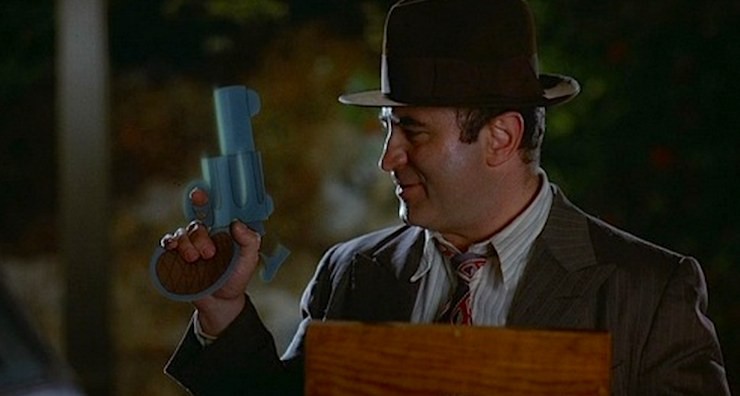
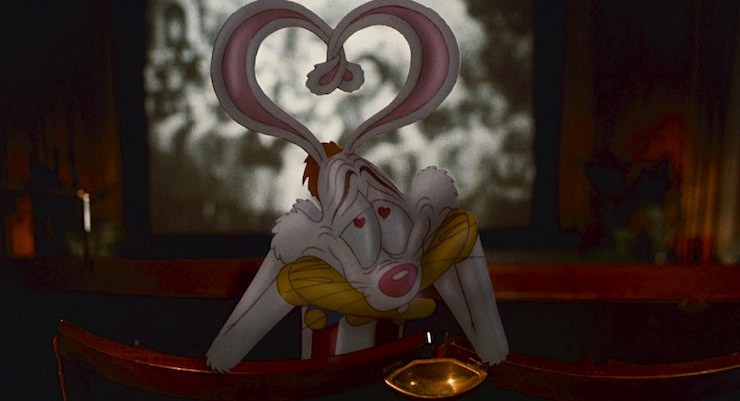
Reading this makes me remember how much I loved this movie as a kid. I need to hunt it down again. When I was little my favorite part was when the goons laugh themselves to death. I just thought that was HILARIOUS. As a kid, a lot of the noir aspects were lost on me, and I had no idea what was going on with the main plot or what the trolley company had to do with any of it (kind of similar to how I had no idea what was going on with the Building and Loan when I used to watch It’s a Wonderful Life as a kid) but the movie was wacky and I loved it anyway. It also ignited my love of Franz Liszt :)
They couldn’t have gotten Rocky and Bullwinkle in the film, since the movie is set in 1947 and those characters weren’t created until 1959. The filmmakers took great care to avoid anachronisms, and the animators had to fight to use period-accurate character models for the Disney and WB characters over the objections of the marketing departments, who wanted to use their familiar modern versions. In Cinefex issue 35 (p. 23), animation director Richard Williams says, “In a way, I wish we could have included the limited animation characters because my personal favorites are Rocky and Bullwinkle and the Jay Ward guys — but they wouldn’t have fit in with the rest of the characters. I don’t know what Rocky would have looked like with a bunch of tone mattes and shadows on him.” So it’s not that they actually tried to get those characters and couldn’t; it’s that Williams would’ve liked it in theory, but knew it couldn’t work.
Correction on the bicycle: They did not simply give up and let the bike fall over. Rather, FX assistant Don Elliot eventually hit upon the very simple method of filling the tires with water. As Elliot explained in the same Cinefex article (p. 12), “Not only did the water stabilize the bike and keep it balanced, but the weight of it also kept the tires moving forward, causing the pedals to rotate. You could get the bike running and it would go straight.” Although they did use a cable to keep it on course.
Also, “greenscreen” is an anachronistic term. Green is the preferred color for chromakey replacement with digital video, so it’s what’s preferentially used today. But Roger Rabbit was shot on film and composited optically, so they used bluescreens for their matte shots.
It’s hard in these days when so many people assume that “CGI” is synonymous with “visual effects” to appreciate just what a brilliant technical achievement WFRR was. Aside from the use of computerized motion-control cameras, pretty much the whole movie was done without modern computer effects. They used a wealth of different techniques to create the interactions between toons and physical people and objects, and mechanical-effects supervisors George Gibbs and Michael Lantieri are among the unsung heroes of the film. A lot of it was essentially “invisible man” effects, moving things around with wires, or with rods that would be hidden behind the animation. For Jessica’s interactions with Eddie and others, they animated Jessica’s head and arms over the movements of actress Betsy Brantley — but they had to use motion-controlled split-screen shots to erase the lower half of Brantley’s body because Jessica’s wasp waist was too small to cover it. And the animation was unusually complex; on top of the conventional animation, there were whole teams devoted to creating and compositing the interactive lighting and shadows onto the Toons to make them look 3-dimensional. It was incredibly labor-intensive; they had to do 1300 composite shots for the film in 8 months, which was about as many composites as ILM had done in the previous three and a half years. The film is one of the greatest visual-effects achievements of the pre-CGI era — and therefore one of the greatest of all time, if you ask me, because CGI makes things so much easier.
I too loved this movie, and it was learning how they did the blended filming that actually got me interested in how movies are made.
The weasels dying was a good part, yes, but I still think my fave is Roger having spasms to try not to finish Doom’s “Shave and a Haircut” bit.
Plus, Kathleen Turner. I’ve loved her in everything, and that she was the voice of Jessica Rabbit made Jessica my FAVORITE CARTOON characte
@2 As a longtime cartoon buff, I appreciated that the animators tried to keep the characters drawn in the style of 1947. Daffy Duck in particular was modeled both in design and personality to the “wild and crazy” Daffy animated by Rod Scribner in the Bob Clampett- and Bob McKimson-directed cartoons of the mid-1940’s.
However, Betty Boop was drawn more in her pre-1934 style. When the Motion Picture Code was imposed, she was drawn in a more matronly form. If she’d been out of work since 1938, she should have looked more like that.
Jessica Rabbit was an obvious tribute to “Red,” the sexy chanteuse who appeared in several Tex Avery MGM cartoons at that time.
As I understand it the absence of Popeye was largely the result of a legal impasse between Time Warner (which owned the Fleischer/Paramount animated cartoons) and King Features Syndicate (which owned the rights to the characters through their ownership of the original Thimble Theater comic-strip on which the animated cartoons was based).
@4/Russell H: Well, if the conceit is that Toons are real people who are just being photographed, then the changes we see onscreen would just be analogous to how actors change their look over time, whether through aging or through deliberately altering their image, gaining or losing weight for a part, etc. Maybe Betty Boop toned down her sexiness in the later cartoons because that was what the Code required, but when she got the job at the nightclub, she got “back in shape” to the way she’d looked before.
Oh, by the way, there were actually two Warner Bros. characters that Mel Blanc didn’t play here. Both Yosemite Sam and the similarly loudmouthed Foghorn Leghorn were voiced by Joe Alaskey, who’s since become the regular voice of Daffy Duck and has played other Looney Tunes characters in various productions (for instance, he was Bugs, Daffy, and others in Joe Dante’s Looney Tunes: Back in Action). Alaskey also played Plucky Duck in Tiny Toon Adventures.
The Disney toons were played by their usual modern actors — Wayne Allwine as Mickey, Tony Anselmo as Donald, Russi Taylor as Minnie. Droopy was played by animation director Richard Williams himself. Woody Woodpecker was performed by Cherry Davis, who’s never played the role anywhere else.
Regarding the period-accurate cartoon models (more or less), I was really pleased on a recent rewatch of this that they sort of cheat with Bugs; he’s drawn in the more modern style–leaner, that sort of blue-er grey tone, more puffed out cheeks–but as he freefalls, the wind pushes his cheek fur into the sleeker profile shape he had in the mid-1940s.
Also while finding images for this post, I finally noticed all the extra detailing with added shadows and reflections for the toons, to really make them look as solid as possible in the human world. Hats off to ILM on this one.
I’d like to see this in its entirety again. I saw in the theater (as a double feature with Newsies), but since then, only a couple of times on tv, and then maybe not the whole thing.
What an amazing performance by the late Bob Hoskins. He also told a great story about how his son refused to talk to him during the filming of the movie because Bob hadn’t brought home any of his animated co-stars.
This one was fun from beginning to end. One of the few times that mixing live action and animation worked well in the movies. There were so many bits in this movie that were so good that you hardly noticed the few things that didn’t work as well. And Hoskins was brilliant; totally believable, which helped keep the movie grounded.
Just a great film. As someone who grew up watching both Disney and WB animation the film just nailed my love for both studios. The casting of Bob Hoskins and Christopher Lloyd was just perfect and Kathleen Turner’s voice work for Jessica Rabbit was unforgettable.
Loved the gags. “Nice booby trap” really stuck in my mind. And as someone who grew up watching the old cartoons on the independent TV stations in the afternoons, I loved the animation.
@11/wiredog: I never understood why the “Nice booby trap” line was redubbed on commercial TV to “Nice one, Jess.” Wouldn’t that be the kind of double entendre that would go over little kids’ heads anyway?
Hah, I haven’t watched this in ages so it never occurred to me that it was using characters from multiple studios! That in itself is an impressive achievement, so thanks for pointing it out.
(And oh,Tiny Toons and Animaniacs!)
I was so young when I watched this in the cinema that I was trying to figure out what picture frames had to do with anything. Loved the film anyway though. It’s especially great on DVD as you get a few Roger Rabbit and Baby Herman shorts as a bonus.
@13, It was the original crossover!
I get the idea Spielberg will need to pull some similar strings in order to make Ready Player One anything close to what it should be.
Great memories!
This movie needs to have an extension film. Prequel, sequel, it doesn’t matter, as long as we can see Roger, Jessica, Baby Herman, etc. back on the screen.
@18/Peter Fay: That’s what the short films were for, wasn’t it?
Besides, with Bob Hoskins no longer with us, it wouldn’t be the same.
So tell me Christopher L. what did you think of the story overall?